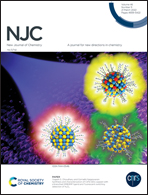Fabrication of tailored rod-shaped carbon nitride, g-C3N4, decorated with MoSe2 flowers for the catalytic reduction of nitrophenol, organic dye degradation and biocompatibility studies†
Abstract
A facile hydrothermal approach was used to synthesize a self-assembled tailored rod-shaped g-C3N4 anchored with molybdenum diselenide (MoSe2) flowers. Due to the presence of basic sites, MoSe2 can be loaded on the surface of the rod-type morphology of g-C3N4. The as-prepared materials were characterized using several techniques. The catalytic activities of the as-prepared g-C3N4/MoSe2 (CNM) composites were assessed by the catalytic reduction of harmful nitroarenes such as 4-nitrophenol (4-NP) and the organic dye rhodamine-B (RhB) together with NaBH4 in an aqueous solution. The as-synthesized CNM catalysts exhibit good performance toward both the catalytic reduction of 4-NP and degradation of the RhB dye. The results obtained indicate that among all the composites prepared, the CNM (6 : 1) shows the best reduction rate in 4-NP conversion, with a reduction efficiency of 99.70% in 6 min and degradation of RhB with 98% in 3 min. The synergic effect of MoSe2 flowers decorated on g-C3N4 promotes the electron transfer that is responsible for the highest catalytic reduction of 4-NP. The reduction and degradation mechanisms were also elucidated and discussed. The reusability study of the catalyst shows good results during the consecutive degradation and reduction experiments. Biocompatible studies on CNM (6 : 1) showed promising results for future prospects in biological applications. The material synthesized can serve as a novel heterogeneous catalyst for the removal of toxic contaminants and open new avenues for other useful applications.



 Please wait while we load your content...
Please wait while we load your content...